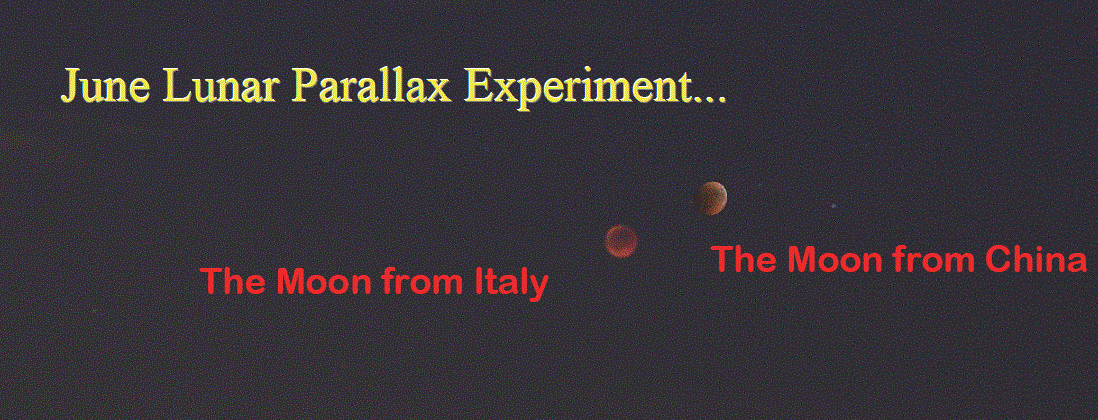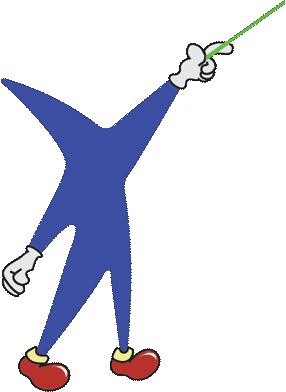|
How do
you take
good photographs of a lunar eclipse?
Here are three
photographers' advice on 'shadow
shooting'!
Advice
from
Italy

From
Italy, here's how the panorama (minus the
Chinese moon image) was taken
If you wish to learn
the basics of astrophotography, the Moon would be your
best choice:
it's easy to spot, it's easy to align your instrument
with, it's very
bright and it also allows you to increase exposure
times at
low magnifications.
But if you'd like to get
nice photos out of a lunar eclipse, it'll get a little
harder than
that. If you're not familiar with astrophotography,
you can get great
results even without a telescope:
just get your DSLR, a 70mm lens, a
stable mounting and you'll be ready to go.
You can setup your
camera with a remote controller or with a software
provided when you
first bought it: connect your DSLR to your laptop and
you can set the
camera without even touching it. It's very useful and
you get full
control of each settings.
Because during a lunar
eclipse the moon's brightness will lower a lot, it's
very important to
keep changing exposure times throughout the whole
event. I'd suggest to
set the camera's sensitivity between 500 and 640 ISO,
to keep full
aperture and set exposure time between 4 and 10
seconds for each shoot.
When you're about the totality, you may want to push
exposure times a
little bit longer in order to get better results on
your final sequence.
During the
last lunar
eclipse, in Italy things were even harder: it was just
after sunset,
the sky was still bright... so we basically had to
change exposure
times both to match the sky getting darker as well as
the moon losing
its brightness, but the two things didn't happen at
the same time, so
it was a lot of fun!
--Fabio Checchin, Dario Tiveron, Giacomo Maltese
Gruppo Astrofili di
Padova
Advice from
Turkey
- Camera: Panasonic DMC-FZ8
- Taken on 2011/06/15
22:26:37
- Exposure: 1.000s
- Focal Length: 66.70mm
- F/Stop: f/3.300
- ISO Speed: ISO200
- Exposure Bias: 0.00 EV
- No flash
and
this is my camera's
properties;
Product Features
- 12x Optical, 4x Digital Zoom
- Leica DC Vario-Elmarit Lens - 11
elements in 8 groups (3
Aspherical lenses / 3 Aspherical
surfaces)
- 2.5-inch Polycrystalline TFT LCD (207
K Pixels), 100% Field
of View, Turkish language
7.2 Megapixels, up to 3072 x 2304 resolution,
848 x 480 at 30 fps - We
recommend purchasing a 1GB SD Memory Card for
practical usage
Technical
Details
- Brand Name: Panasonic
- Model: DMC-FZ8P-K
The photo which is taken at night is a matter of patience. If
you are an amateur like
me, you may
need to
try a lot
of times. At
least, you should use semiprofessional
machine. I advise
you to
use a
tripod for night shots. If you
haven't got any tripod, you should
fix your machine on the ground.
When you
press
the shutter
button, the camera vibrates;
to stop the
vibration, you can use the
automatic timer. Also, you can
use exposure
control types (Candle or
Starry sky mode).
Best wishes from Turkey to
everybody.
Se�il
Berna KUZU
ADANA/TURKEY
Advice
from China
You
need a telephoto lens. The moon looks too
small if you don�t
use a telephoto lens. The camera I used last
time was a Canon 5D with
70-200mm lens. It would be better if I had used
a larger lens than
200mm. The shooting mode was manual mode
(M). Since
the (eclipsed) moon�s brightness is
constant, you need to
set the mode only once. I think we don�t need
automatic mode in
this situation. The easiest way to find
the exposure ... is just
trying it. I say this because digital cameras
are very popular these
days. When you use digital camera, take a
picture and check it out.
Take a picture and enlarge the image to make
sure your exposure is
appropriate. Of course the exposure might be
rather longer than usual. So if you find
the proper exposure, as mentioned
above, you can keep taking pictures. You may
check the pictures from
time to time to make sure.
When
I took the lunar eclipse pictures, I suddenly
got the feeling that it would be great to get
the dark part of the
moon which was hidden by the shadow of the
earth. If you want to do
this, you need to set the exposure longer.
For example, in my
pictures, my exposure was ISO 400,
aperture 5.0, and shutter
speed 1/30 second when I focused on the brighter
side of the moon. When
I took the photos of shadow, I used ISO 800,
aperture 4.0 and shutter
speed 1.3 seconds. The difference between
the exposures of
brighter side and the dark side is more than six
stops. One stop means
50% difference of light exposure.
I
want to point
out that it would be better to determine the
exposure in the situation
because the exposure value can vary depending on
many
variables.
There are a
couple of more things to suggest. First, because
the moon moves, the
picture will be blurry if the exposure time is
too long. When I took
the pictures, the shutter speed was too
long (eight
seconds). If taken with 200mm lens, as
long as 1.3 seconds was
acceptable. If your lens is less than 200mm,
your shutter speed needs
to be shorter. The only way to make your photos
brighter in this
situation is to make your ISO higher, and a
tripod is
essential! You cannot shoot a lunar
eclipse without a
tripod. Even if you use a tripod, it would
be a good idea to use a
remote controller or a release instead of
pressing the shutter button
in order to prevent the effect of your finger
pressure when you take a
picture. If you don�t have such accessories, you
can use a timer
when you take a photo.
An Kwang Jin (Korean
photographer
in Qingdao, China).
|
|
